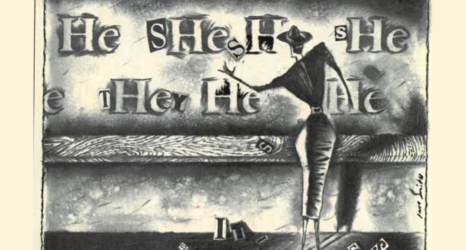The sweet J. Crew ad I celebrated last week has ignited a “pink scare,” with socially conservative commentators outrageously upset. The ad features a mother– J.Crew’s creative director, Jenna Lyons–and her son delighting in one another’s company on a Saturday afternoon by painting their toenails hot pink (and thereby selling J. Crew’s Essie nail polish). The ad doesn’t make much fanfare of the nail painting and is fairly inconspicuous. As Melissa Wardy, founder of Pigtail Pals- Redfine Girly, comments on Good Morning America‘s coverage of the gendered hoopla:
The camera has to zoom in SO much on the toes to make the news story, you completely lose sight of the delightful moment between loving, doting mother and happy, beautiful son.
In, what Nikita Blue calls, “ominous paranoid ramblings,” Dr. Keith Ablow goes off in a “conspiracy-theorist tangent,” claiming this ad contributes to “psychological sterilization,” erases gender differences and homogenizes males and females by propagandizing them to choose a gender identity that is not the “natural” one they were born with:
Well, how about the fact that encouraging the choosing of gender identity, rather than suggesting our children become comfortable with the ones that they got at birth, can throw our species into real psychological turmoil—not to mention crowding operating rooms with procedures to grotesquely amputate body parts?
Media Research Center’s Erin Brown claims the ad exploits Lyons’ son, Beckett, through the “blatant propaganda celebrating transgendered children.” According to Brown, ads like these and irresponsible mothers such as Lyons will create more confused boys, much like the controversial “Princess boy.”
Sexist and homophobic concerns like the ones expressed by Ablow and Brown raise several important points worth exploring. First and foremost, the notion that there is a direct correlation between color, gender and sexual identity is ludicrous. Color codes are recent social inventions, constructs originally inverse. Phyllis Burke’s Gender Shock and Peggy Orenstein’s Cinderella Ate My Daughter trace the sociohistorical origins of pink and blue segregation–gendered coding that wasn’t instilled until the early 20th century. Prior to that, glancing at a babies clothing didn’t reveal any trace of gendered identity: They all wore white gowns. Photographs of my great-grandparents, both born circa 1902, are identical and indistinguishable. Check out this photo of Franklin D. Roosevelt in 1884!
Once color coding got underway in earnest, the colors were reversed. Pink, a color close to red, was equated with strength and masculinity. Light blue was a “natural” sign of femininity and, according to Orenstein’s reasearch, equated with “intimations of the Virgin Mary, constancy, and faithfulness.” Given that history, it becomes clear that color codes are arbitrary, socially constructed and have no bearing or impact on one’s “natural” gender or sexual identity. As Dr. Logan Levkoff explains:
Dear Fox, colors don’t have genders. Colors are just colors. Liking certain colors [doesn’t] mean you like girls or boys, or want to be either of them, now or in the future.
Secondly, there’s nothing “natural” about gender. Gender is a social construct reflecting cultural dictates within a specific historical context and those gendered prescriptions change as the culture changes. Just as culture is dynamic and fluid, so are gendered expectations. Obviously, Ablow and Brown aren’t familiar with the difference between the biological concept of sex, referring to maleness and femaleness and the continuum between the two, and gender, the socially constructed definitions and expectations of masculinity and femininity. Their critiques of J. Crew’s ad demonstrates rampant essentialism–the idea that one’s biological sex is destiny while ignoring historical and contemporary contradictions to that idea. If having a penis “naturally” led boys and men to embody “masculinity” and a vagina “naturally” equated with all things “feminine,” we’d see much more historical and cultural uniformity.
Third, not only is the idea that the J. Crew ad squelches “naturally” assigned gender identity ridiculous given the difference between biological sex and socially constructed gender, but Ablow’s quote doesn’t address the real culprit in stifling natural and healthy explorations: the color-coded assault by marketers on children’s play. It seems to me that the hyper-segmented pink world of the princess and the blue world of the boy warrior is much more responsible for shaping gender identity than an ad featuring hot-pink toenails on a boy. In that way, J. Crew is a small sign of opening up gendered possibilities–possibilities that represent authentic personal choice.
In Brown’s opinion piece, she goes on to say that mothers such as Lyons or Sarah Manley are setting up their sons for a hard time in the future. There she’s right, and this gets to the crux of the issue. The system of patriarchy values masculinity and devalues femininity. In fact, within patriarchy, masculinity is a fundamental mainstream cultural value. In the Good Morning America segment, Manley rightly points out that if the ad featured a girl playing with trucks in the mud there wouldn’t have been this type of outcry. While girls are awash in a sea of pink, they are more likely to be encouraged and celebrated for exploring and developing “masculine” characteristics, while boys are discouraged and shamed for developing “feminine” characteristics precisely because of masculinity’s cultural capital. What Ablow or Fox don’t acknowledge is that these are simply human characteristics, gendered one way or the other and thereby differently valued. As I wrote on my Feminist Fatale blog last week:
When a 17-month-old boy is beaten to death for being too “girly,” a five-year-old is accused of being gay for choosing to dress up like Daphne from Scooby-Doo for Halloween, a boy who likes pink dresses causes headline news and a high-school football player is kicked off the field for wearing pink cleats during Breast Cancer Awareness Month, I think it’s more than obvious that social expectations regarding femininity and masculinity continue to be incredibly rigid, stifling and too often dangerous.
J. Crew’s ad doesn’t depict misguided and dangerous decisions made by J. Crew or parents like Jenna Lyons. The reactions and social outcry against it depict the dangerous world of gender policing within the system of patriarchy.
Close-up of ad via J. Crew





